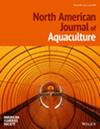水族箱观赏鱼生产过程中水生植物对硝酸盐和磷酸盐的去除
IF 1.3
4区 农林科学
Q3 FISHERIES
引用次数: 0
摘要
目标通过工业化生产满足水族馆对观赏鱼和观赏植物日益增长的需求。然而,较高的生产密度可能会对水质(如氨氮、硝酸盐、亚硝酸盐和溶解氧水平)产生负面影响,从而影响生产。通过利用特定的水生植物来促进观赏鱼的可持续生产,可以缓解这一问题。本研究旨在确定如何利用两种漂浮水族植物改善观赏鱼缸的水质:方法在饲养 Endler Guppies Poecilia wingei 的水族箱中测定这两种植物过滤硝酸盐和磷酸盐的效率。研究持续了 4 周,每周测量一次水质参数。在研究开始和结束时,对两种植物的生长率进行了测量。结果 金鱼草能有效维持较低的硝酸盐和磷酸盐水平,同时表现出强劲的生长势头。在两个独立实验中,到第 4 周时,对照组水槽中的硝酸盐含量分别升至 33.75 和 35.00 毫克/升,而种植了纳佳斯草的水槽中的硝酸盐含量仅为 8.75 和 11.50 毫克/升。对照水槽中的磷酸盐含量分别升至 2.42 和 2.40 毫克/升,而在种有纳贾斯草的水槽中,磷酸盐含量分别为 1.075 和 1.05 毫克/升。在单一物种水槽中,纳贾斯草的生物量增加了 1.6 倍,而爪哇苔藓则增加了 1.2 倍。结论 纳贾斯草的卓越竞争能力(等位基因和更多的营养吸收)是本研究结果的基础,表明该物种是维持水族箱水体中低水平硝酸盐和磷酸盐的更好选择。这一发现有助于为工业化观赏鱼生产和贸易中的鱼类物种创造更清洁、更健康的环境。本文章由计算机程序翻译,如有差异,请以英文原文为准。
Removal of nitrate and phosphate by aquatic plants during aquarium‐based ornamental fish production
ObjectiveThe rising demand for ornamental fish and plants in aquariums is met through industrial production. However, higher production densities may negatively impact water quality (such as ammonia, nitrate, nitrite, and dissolved oxygen levels), thus impacting production. This can be mitigated by utilizing specific aquatic plants to promote sustainable ornamental fish production. This study aimed to determine how the water quality in ornamental fish tanks can be improved using two floating aquarium plant species: Najas grass Najas guadalupensis and Java moss Taxiphyllum barbieri .MethodsThe efficiency of nitrate and phosphate filtration by the two plant species was determined in aquariums containing Endler Guppies Poecilia wingei . The duration of the study was 4 weeks, and the water quality parameters were measured weekly. The growth rates of the two plants were measured at the beginning and end of the study period.ResultNajas grass effectively maintained lower nitrate and phosphate levels while showing robust growth. By week 4, nitrate levels in control tanks rose to 33.75 and 35.00 mg/L in the two independent experiments, while nitrate in tanks with Najas grass only reached 8.75 and 11.50 mg/L. Phosphate levels in control tanks increased to 2.42 and 2.40 mg/L compared to 1.075 and 1.05 mg/L in tanks with Najas grass. In single‐species tanks, Najas grass showed a 1.6‐fold biomass increase, while Java moss showed a 1.2‐fold increase. In tanks with both species, Najas grass biomass increased significantly, whereas Java moss biomass decreased.ConclusionThe superior competitive ability of Najas grass (allelopathy and increased nutrient uptake) underlies the findings of this study and indicates that this species is a better option for maintaining low levels of nitrate and phosphate in aquarium water. This finding can contribute to creating a cleaner and healthier environment for fish species involved in industrial ornamental fish production and trade.
求助全文
通过发布文献求助,成功后即可免费获取论文全文。
去求助
来源期刊
CiteScore
2.50
自引率
0.00%
发文量
46
审稿时长
18-36 weeks
期刊介绍:
The North American Journal of Aquaculture publishes papers on new research and practical experience in all areas of intensive and extensive fish culture. Topics include broodstock selection and spawning, nutrition and feeding, health and water quality, facilities and production technology, and the management of ponds, pens, and raceways.
The journal will consider papers dealing with ways to improve the husbandry of any aquatic species—marine or freshwater, vertebrate or invertebrate—raised for commercial, scientific, recreational, enhancement, or restoration purposes that may be of interest to practitioners in North America. Its scope includes both basic and applied science, but applied scientific endeavors—including practical experiences, descriptive studies, and other nontraditional, but pertinent works—are emphasized.

 求助内容:
求助内容: 应助结果提醒方式:
应助结果提醒方式:


